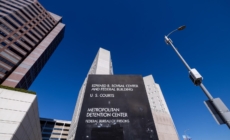-
DOGE Cuts Update: 121 Contracts Worth $350M Eliminated in Days - 25 mins ago
-
Path to a Trump Pardon: Devon Archer, a Biden Loyalist, Goes ‘Full MAGA’ - 44 mins ago
-
Denmark Issues Warning to JD Vance: ‘We Don’t Appreciate the Tone’ - 60 mins ago
-
Volunteer Rescuers in Mandalay Sift Through Earthquake Rubble - about 1 hour ago
-
Myanmar Earthquake Death Toll Could Be up to 100,000: USGS - 2 hours ago
-
Environmentalists outraged as EPA invites polluters to email for exemptions - 2 hours ago
-
Ryan Coogler Reacts to Denzel Washington Joining ‘Black Panther 3’ - 2 hours ago
-
Ilia Malinin Is Poised to Win World Figure Skating Championships on Saturday - 2 hours ago
-
Fashion-Forward Bird Wins Pet of the Week With Bold Style - 3 hours ago
-
California waives environment laws to speed utility rebuild after fires - 3 hours ago
Solar Eclipse Path Map For March 29 Shows Where Sun Will Be Blocked Out
Millions of Americans may have the chance to witness a partial solar eclipse on March 29, when the moon passes between the Earth and the sun, temporarily obscuring part of the solar disk.
While not as dramatic as a total eclipse, the event is expected to be visible in Europe, western Africa and North America, with parts of Canada expecting about 93 percent of the sun to be blocked.
Across the continental United States, varying degrees of partial obscuration are set to occur, with the highest percentages expected in the Northeast—including major cities such as New York and Boston.

Ernie Wright/NASA
What Is the Partial Solar Eclipse?
A partial solar eclipse occurs when the moon covers only a portion of the sun’s disk, creating a “bite” effect in the solar surface. Unlike a total eclipse, where the moon completely blocks the sun, a partial eclipse does not darken the sky significantly. However, it still requires eye protection for safe observation.
What Time is the Partial Solar Eclipse?
Timings vary depending on location. According to a detailed viewing guide by Forbes, the eclipse is set to begin shortly after sunrise in parts of the northeastern United States, such as Portland, Maine, where up to 64 percent of the sun is expected to be obscured and sunrise is set for 6:27 a.m. Eastern time.
In New York, up to 22 percent of the sun is expected to be obscured after sunrise at 6:44 a.m.
The eclipse may be barely noticeable in the southeast, with cities such as Washington, D.C., expecting about 1 percent of the sun to be blocked, Forbes reported.
According to Timeanddate.com, the U.S. is set to experience the partial solar eclipse on Saturday between 6:13 a.m. and 7:17 p.m. EDT. The event is expected to last less than an hour in most locations.
Partial Solar Eclipse Path
The event is set to be visible, to varying degrees, from 12 states and Washington, D.C.: Connecticut, Delaware, Maine, Maryland, Massachusetts, New Hampshire, New Jersey, New York, Pennsylvania, Rhode Island, Vermont and Virginia.
Despite technically being visible in the 13 areas mentioned above, the weather will also factor into where the eclipse’s path can be seen clearest. Meteorologist Tyler Roys told Newsweek that a stretch from upstate New York through Vermont, New Hampshire, and southern Maine is expected to see poor conditions Saturday morning due to a wintry mix of rain, freezing rain, and sleet. In contrast, far northern Maine and parts of southern New England — including Long Island and New York City — should experience fair to possibly good conditions.
What Happens Next
The next partial solar eclipse is expected to occur on September 21 and be visible in the Southern Hemisphere.
Those viewing the partial eclipse are advised to follow safe viewing practices, as observing the sun without proper eye protection can cause permanent damage.
Source link



















